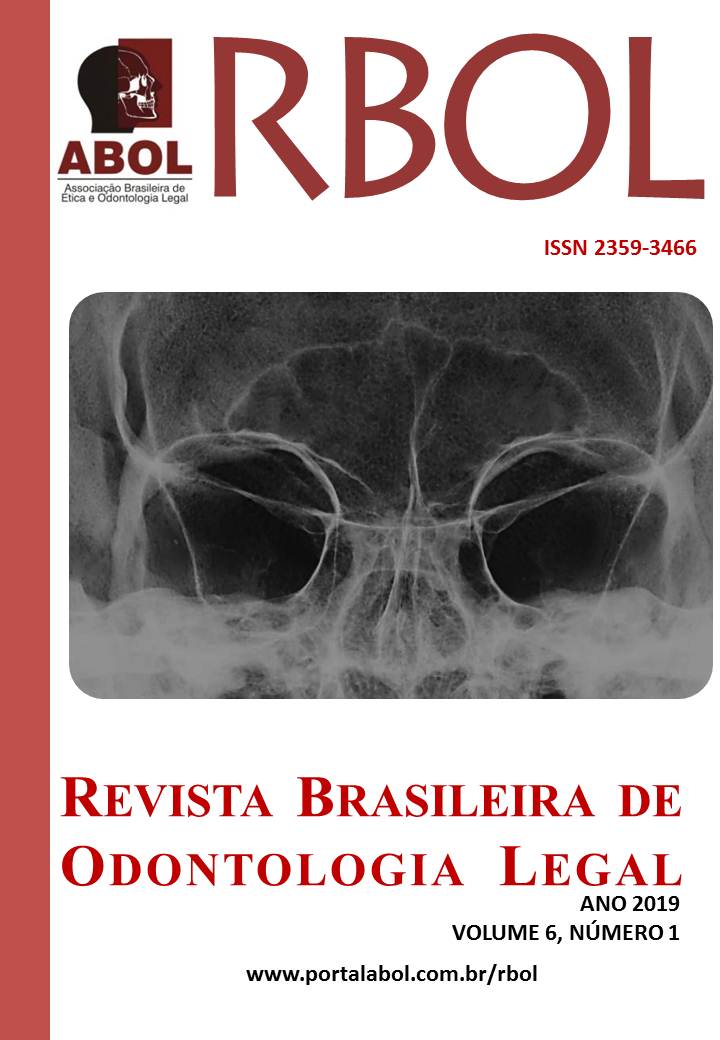HUMAN IDENTIFICATION ESTABLISHED BY THE ANALYSIS OF FRONTAL SINUS SEEN IN ANTEROPOSTERIOR SKULL RADIOGRAPHS USING THE MENTO-NASO TECHNIQUE – A FORENSIC CASE REPORT
DOI:
https://doi.org/10.21117/rbol.v6i1.222Palavras-chave:
anatomy, forensic odontology, frontal sinus, human identification, radiologyResumo
Introduction: Human identification is a challenging task, especially when the available information detected during the dental autopsy is scarce. In this context, distinctive morphological information may play a valuable role as additional and alternative identifiers. Objective: To report a case of human identification aided by the morphological analysis of the frontal sinus through anteroposterior radiographs of the skull with the mento-naso technique. Material and methods: The body of an edentulous adult male highly decomposed was referred to the local medico-legal institute for identification. The alleged relatives of the victim provided the comparative antemortem data (AM) – consisting of an anteroposterior (AP) skull radiograph taken with mento-naso projection. A postmortem AP radiograph of the deceased was taken in order to reproduce the AM data and to enable a comparative procedure. Results: The morphological information of the frontal sinuses converged between AM and PM radiographs both for metric and non-metric evidences. Conclusion: The analysis of the frontal sinus may be an additional and alternative approach for human identification – especially for edentulous victims.
Referências
Gonçalves A, Marcelino J, Prado M, Silva R. Identificação humana utilizando radiografia PA de seios maxilares: relato de caso. Rev Bras Odont Legal. 2014; 1(1):30-9. http://dx.doi.org/10.21117/rbol.v1i1.5
Belaldavar C, Kotrashetti VS, Hallikerimath SR, Kale AD. Assessment of frontal sinus dimensions to determine sexual dimorphism among Indian adults. J Forensic Dent Sci. 2014; 6(1):25-30. http://dx.doi.org/10.4103/0975-1475.127766
Ribeiro FA. Standardized measurements of radiographic films of the frontal sinuses: an aid to identifying unknown persons. Ear Nose Throat J. 2000; 79(1):26-8;30,32-33.
Wormald PJ, Hoseman W, Callejas C, Weber RK, Kennedy DW, Citardi MJ, et al. The International frontal sinus anatomy classification (ifac) and classification of the extent of Endoscopic Frontal Sinus Surgery (EFSS). Int Forum Allergy Rhinol. 2016; 6(7):677-96. http://dx.doi.org/10.1002/alr.21738
Verma S, Mahima VG, Patil K. Radiomorphometric analysis of frontal sinus for sex determination. J Forensic Dent Sci. 2014; 6(3):177-82. http://dx.doi.org/10.4103/0975-1475.137052
Newcomb T, Bruhn A, Giles B. Mass fatality incidents and the role of the Dental Hygienist: are we prepared? J Dent Hyg. 2015; 89(3):143-51
Silva R, Vaz CG, Domiciano M, Franco A, Nunes C, Prado M. Radiographic alterations of the frontal sinus morphology according to variations of the vertical angle in posteroanterior radiographs of the skull. Acta Scient Health Sci. 2014; 32(1):113-7. http://dx.doi.org/10.4025/actascihealthsci.v36i1.20243
Kim DI, Lee UY, Park SO, Kwak DS, Han SH. Identification using frontal sinus by three-dimensional reconstruction from computed tomography. J Forensic Sci. 2013; 58(1):5-12. http://dx.doi.org/10.1111/j.1556-4029.2012.02185.x
Beaini TL, Duailibi-Neto EF, Chilvarquer I, Melani RF. Human identification through frontal sinus 3D superimposition: Pilot study with Cone Beam Computer Tomography. J Forensic Leg Med. 2015; 36:63-9. http://dx.doi.org/10.1016/j.jflm.2015.09.003
David MP, Saxena R. Use of frontal sinus and nasal septum patterns as an aid in personal identification: A digital radiographic pilot study. J Forensic Dent Sci. 2010; 2(2):77-80. http://dx.doi.org/10.4103/0975-1475.81286
Downloads
Publicado
Edição
Seção
Licença
Os autores deverão encaminhar por email, devidamente assinada pelos autores ou pelo autor responsável pelo trabalho, a declaração de responsabilidade e transferência de direitos autorais para a RBOL, conforme modelo abaixo.
DECLARAÇÃO DE RESPONSABILIDADE E TRANSFERÊNCIA DE DIREITOS AUTORAIS
Eu (Nós), listar os nomes completos dos autores, transfiro(rimos) todos os direitos autorais do artigo intitulado: colocar o título à Revista Brasileira de Odontologia Legal - RBOL.
Declaro(amos) que o trabalho mencionado é original, não é resultante de plágio, que não foi publicado e não está sendo considerado para publicação em outra revista, quer seja no formato impresso ou no eletrônico.
Declaro(amos) que o presente trabalho não apresenta conflitos de interesse pessoais, empresariais ou governamentais que poderiam comprometer a obtenção e divulgação dos resultados bem como a discussão e conclusão do estudo.
Declaro(amos) que o presente trabalho foi totalmente custeado por seus autores. Em caso de financiamento, identificar qual a empresa, governo ou agência financiadora.
Local, data, mês e ano.
Nome e assinatura do autor responsável (ou de todos os autores).

